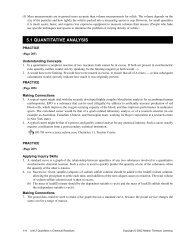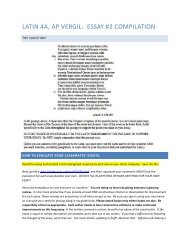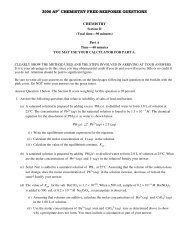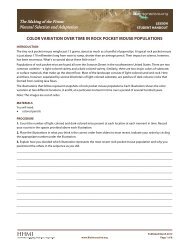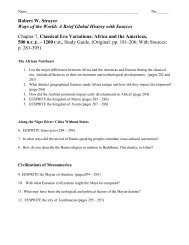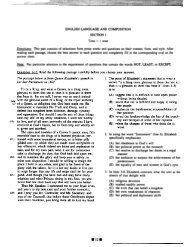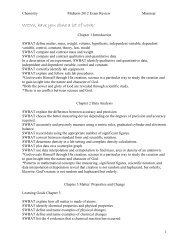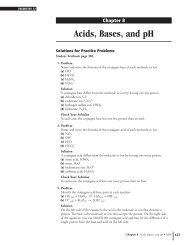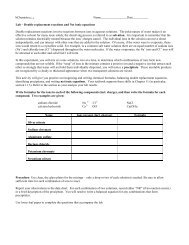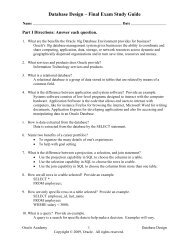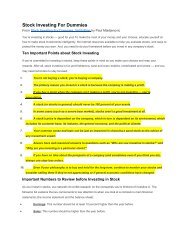Chromosomes and Mendelism.pdf - Quia
Chromosomes and Mendelism.pdf - Quia
Chromosomes and Mendelism.pdf - Quia
You also want an ePaper? Increase the reach of your titles
YUMPU automatically turns print PDFs into web optimized ePapers that Google loves.
<strong>Chromosomes</strong> <strong>and</strong> <strong>Mendelism</strong><br />
<strong>Chromosomes</strong> were discovered in the late nineteenth century.<br />
Thanks to Ernst Abbe <strong>and</strong> Karl Zeiss, advances in microscopy allowed scientists to<br />
view chromosomes within the nuclei of cells that have a nucleus. Zeiss lenses are still<br />
today considered the best in the world!<br />
Each species' chromosomes are distinguishable in number <strong>and</strong> physical appearance.<br />
At times when cell division is not imminent, chromosomes appear as a diffuse<br />
network of fine threads within the nucleus referred to as chromatin.<br />
When cell division nears, chromatin of each chromosome condenses to form the<br />
distinguishable structures that can help characterize a species.<br />
Some regions of the chromatin are dark staining <strong>and</strong> are more tightly packaged<br />
during interphase than other regions. These are called heterochromatin.<br />
Euchromatin is less densely packaged when compared to heterochromatin.<br />
<br />
<br />
Hetero means different.<br />
Eu means true.<br />
<strong>Chromosomes</strong>, except sex chromosomes, exist in pairs in diploid organisms like<br />
humans <strong>and</strong> garden peas.<br />
Gametes have just half the number <strong>and</strong> are called haploid.<br />
Many plants <strong>and</strong> animals tolerate a change in the number of complete sets of<br />
chromosomes.<br />
If there are four sets, the organism is called a tetraploid.<br />
If eight sets, the organism is called an octoploid.<br />
Tom Mueller RHS
Chromosomal Theory of Heredity<br />
Around 1910, biologists began to suspect that genes were associated with<br />
chromosomes.<br />
Sutton<br />
Boveri<br />
By 1902 the chromosome movements during meiosis had been worked out, <strong>and</strong> Walter<br />
Sutton (an American) <strong>and</strong> Theodor Boveri (a German) used them to explain Mendel's<br />
laws<br />
It was suspected that genes were composed of protein. <strong>Chromosomes</strong> are composed<br />
of protein as well as DNA. It was observed that during meiosis chromosomes<br />
behaved like Mendel’s elements of inheritance.<br />
Thomas Morgan<br />
Thomas Morgan, a fly guy as we call people that work with<br />
Drosophila these days, helped prove the Chromosome<br />
Theory of Inheritance.<br />
Morgan was an underfunded scientist working in a tiny lab.<br />
He conducted research on a broad range of topics.<br />
Interestingly, he initially doubted the importance of<br />
Mendel’s research <strong>and</strong> Mendelian genetics. It was<br />
Morgan's research that proved the relationship of<br />
Differences in chromosome constitution make drosophila<br />
either male or female. This would constitute the so-called<br />
exception that proved Mendel’s (& Suttons’s) rule!<br />
Sex chromosomes are an exception to the pair rules for diploids<br />
Females have a pair of sex chromosomes but males have a mismatch set, an X <strong>and</strong><br />
what is called a y. (In fact the y-chromosome looks like a small X chromosome when<br />
viewed with a microscope.)<br />
Males of some species have an O, not a y chromosome. The O actually denotes no<br />
chromosome at all.<br />
In humans, sperm carry either an X or a Y, not both.<br />
Therefore, in humans, sex is dictated by the sperm that penetrates the egg.<br />
Too bad nobody told Henry VIII http://www.youtube.com/watch?v=-fadCAHjN-s&hl=fr<br />
Here is another version: http://www.youtube.com/watch?v=BpbdcI5HAYg<br />
In birds, honeybees <strong>and</strong> some varieties of insects – things get more complicated.
The discovery of sex-linked inheritance was an important insight in genetics!<br />
Morgan not only changed his position on Mendel’s theory, but he <strong>and</strong> his colleagues<br />
made other startling discoveries, which firmly established that the genetic<br />
information resided on the chromosomes. With his students Alfred Henry<br />
Sturtevant, Calvin Blackman Bridges, <strong>and</strong> Hermann Joseph Muller, he established<br />
what is now called classical genetics.<br />
Later, Morgan <strong>and</strong> his former students became key scientists in the development of<br />
the then new science of mutagenesis. Morgan with another important scientist even<br />
developed a means to map the locations of genes to positions on chromosomes. We<br />
shall learn this method in another section.<br />
Tom Mueller RHS




